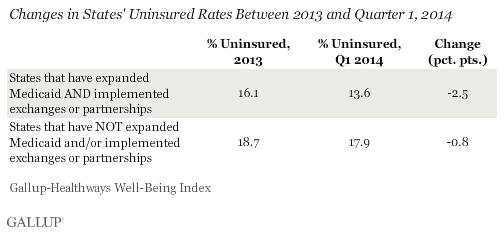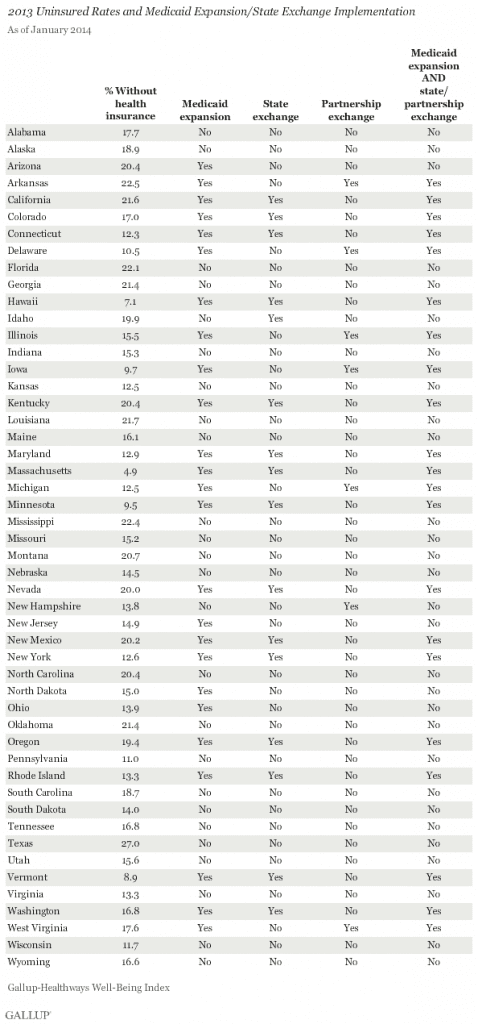The uninsured rate among adults aged 18 and older in the states across the country that have chosen to expand Medicaid and set up their own exchanges in the health insurance marketplace has declined significantly this year, meaning more U.S. citizens are being covered by private health care insurance than ever before, improving the economy at the same time.
Uninsured people are one of the biggest drags on the economy, as President Obama said when he chose to push Congress to pass the Affordable Care Act into law in his first term.
The uninsured rate, on average, declined 2.5 percentage points in the 21 states (plus the District of Columbia) that have implemented both of these measures, compared with a 0.8-point drop across the 29 states that have taken only one or neither of these actions, according to the latest Gallup poll on the subject.
The states that have chosen to expand Medicaid and set up their own healthcare exchanges had a lower average uninsured rate to begin with: 16.1 percent compared with 18.7 percent for the remaining states — a difference of 2.6 points. The already notable gap between the two groups of states widened in the first quarter to 4.3 points.
Nationally, 17.3 percent of U.S. adults reported being without health insurance in 2013, a rate that had slowly increased from 14.8 percent in 2008. The uninsured rate peaked at 18 percent in the third quarter of 2013 — the three months immediately preceding the opening of the healthcare exchanges — and has since declined to 15.6 percent.
Some states have chosen to implement state-federal “partnership” exchanges, for which states run certain functions and make key decisions based on local market and demographic conditions.
Only four states — North Dakota, New Jersey, Ohio, and Arizona — have decided to expand Medicaid without also administering a state-based exchange, while several others continue to debate expanding eligibility.
See chart below for a full list of the status of Medicaid expansion and healthcare exchanges for all states, as well as the 2013 uninsured rates for each.
Implications
“While a majority of Americans continue to disapprove of the Affordable Care Act, also known as ‘Obamacare,’ the uninsured rate appears to be declining, as the law intended,” Gallup says. “In turn, the states (including the District of Columbia) that have implemented two of the law’s core mechanisms — Medicaid expansion and state health insurance exchanges — are realizing a rate of decline that is substantively greater than what is found among the remaining states that have not done so. Consequently, the gap that previously existed between the two groups has now expanded.”
Many states continue to debate implementing these measures. Nebraska’s state government recently voted down Medicaid expansion, while New Hampshire voted to expand, effective July 1. Perhaps no state is being watched more closely than Utah, a conservative state with a Republican governor, Gary Herbert, that is considering Medicaid expansion but under revised, more flexible terms than what the Affordable Care Act provides.
These plans, which include a three-year block grant to cover about 110,000 low-income residents with private insurance, plus cost sharing and work requirements, have fueled ongoing conversations with federal officials at the Centers for Medicare and Medicaid Services. The resolution of these negotiations and Utah’s final decision may ultimately pave the way for more conservative-leaning states to follow, which could prove to be the best source of continued decline in the national uninsured rate in the months ahead.
Survey Methods
Results for 2013 are based on telephone interviews conducted as part of the Gallup-Healthways Well-Being Index survey Jan. 2-Dec. 29, 2013, with a random sample of 178,068 adults, aged 18 and older, living in all 50 U.S. states and the District of Columbia. Results for 2014 are based on telephone interviews conducted with 43,562 respondents between Jan. 2 and March 31, 2014. The margin of sampling error for the two reported groups in 2013 is plus or minus 0.3 percentage points. The margin of error for both reported groups in 2014 is plus or minus 0.6 percentage points.















